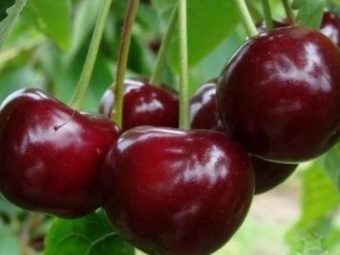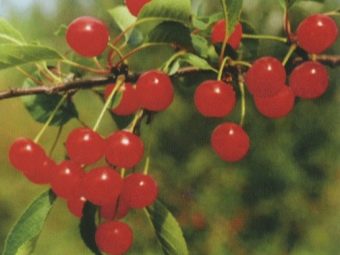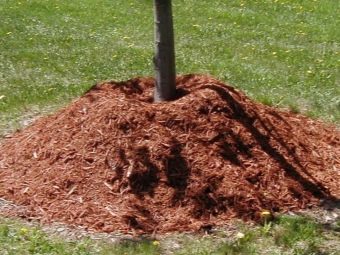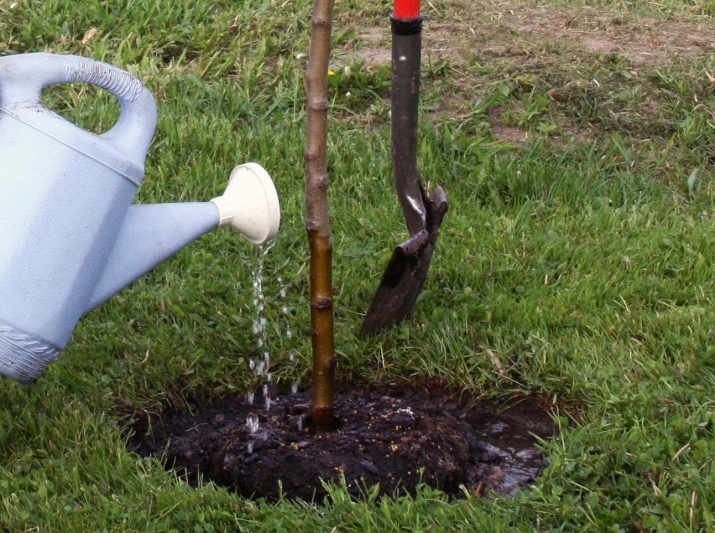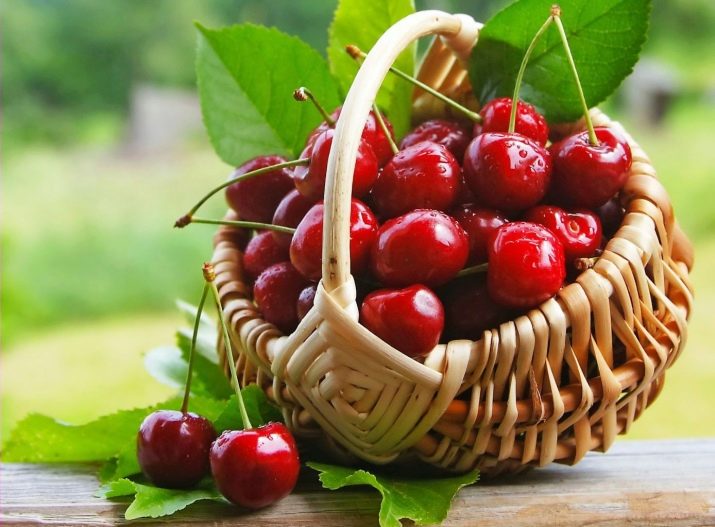Cherry Shpanka: description of the variety and cultivation

The cherry tree is often found in the gardens of our country.There are a lot of varieties of this plant, each of them has its own characteristics. “Shpanka” is an ancient species that was loved by a lot of people for its unpretentiousness and abundant fruiting.
Description
The variety "Shpanka" is a berry tree that reaches a height of 6 meters. Krona is characterized by medium pomp and spherical shape. The trunk of a perennial tree, like the branches, is painted dark brown, the young shoots are a bit lighter. The peculiarity of this variety is manifested in the growth of branches at right angles to the main shoot. Branches do not tend to wilt, so many of them can break or be damaged by the wind, for example, with abundant crops.
Foliage is significantly different from the one that can usually be found on cherry, its shape is more similar to cherry. The leaves are elongated, have a sharp tip and are about eight centimeters long. They are painted in green in different shades. The length and width of the petiole is average, pink outflow is noticeable. When a cherry blossoms, it becomes covered with inflorescences of snow-white color, consisting of two or three flowers.
The tree has an average of precociousness. Also The “key” is a guarantee of a stable annual harvest, the amount of which increases with each season. Peak productivity in the variety comes in fifteen - eighteen years. The average productivity of "Shpanki" is thirty-five - forty kilograms. Life expectancy at the plant is about twenty years.
Fruit size and taste
The fruiting of this sort of cherry is a large-sized berries with a burgundy shade and the presence of a glossy shimmer. Each fruit weighs about five grams, among them sometimes there are specimens with a brown color. The shape of the berries resembles the cherry, it is slightly flattened, has a diameter of one centimeter. The pulp is characterized by juiciness and lack of yellow fibers. This is a dense mass that has a uniform consistency, which is not typical for most cherries.
Juice clear, without scarlet hue. The taste of the fruit "Shpanki" quite pleasant, sweet, it contains a refreshing sour. Small bone, it can easily be separated from the pulp. Berry does not ripen at the same time, usually in June or early July.
Varieties
Common subspecies "Shpanki", which are grown in gardens, can be called the following.
- "Dwarf". This plant, which was the result of mixing cherry and cherry wood. Berries varieties tasty and juicy, with a beautiful bright color. The tree is usually low, the maximum height is three meters.
- "Shpanka Bryansk" is a rather attractive subspecies. Its main advantages are good shipping properties as well as qualities that are ideal for conservation. Due to the density of the structure, cherries can be kept fresh for a long time.
- "Donetsk" - This is a subspecies of "Shpanki", which turned out in the process of crossing cherries with cherries. After planting only three years should pass in order to be able to harvest. This cherry is early, with sweet and sour fruits. "Donetsk" among the rest highlights the wealth of the crop and resistance to changing environmental conditions.
- "Shpanka large-fruited" It tolerates sub-zero temperatures and a dry period. In the third year after planting on the cherry, you can see large berries. On average, the plant has three meters in height. The use of fruits of this variety is popular in all forms.
- "Kursk Shpanka" It gives rich harvests with tasty berries, which have a flattened shape by the 3rd year after planting.
- "Shpanka Shimskaya" - This is a medium-grown tree, which is adapted to sub-zero temperatures and dry conditions. Ripening of large and sweet fruits occurs by the middle of the summer period.
Pros varieties
Cherry "Shpanka" has a lot of advantages compared to other berry trees:
- high frost resistance, the plant has the ability to tolerate temperatures of minus forty degrees;
- good drought resistance, prolonged lack of moisture are not terrible for cherries;
- rare damage by parasites, pests, fungi and infectious diseases;
- stable and high yields, which are up to fifty kilograms per tree per season;
- early maturation;
- berries are characterized by a dense structure and excellent taste.
Minuses
In addition to the advantages of "Shpanki", like any other cherry, there are disadvantages:
- the dimensions of the tree make it difficult to care for it, as well as the destruction of the pest and the collection of fruits;
- low indicator of keeping quality and transportable capabilities;
- small earlyness;
- the need for planting cherry varieties in the area for the pollination process;
- brittle branches due to abundant crops or strong winds, so the branches must be constantly cut.
How to plant?
Cherry "Shpanka" - a plant that negatively relates to heavy soils, and also has many other features that should be considered when planting.
Choosing a place
The southern regions are considered the most favorable place for planting this variety because of sandy, sandy soils and light loams. For normal growth and development, the response of the soil must be neutral or slightly acidic. If at the site groundwater lies close, then the "Shpanku" is to land on a hill or make a mound. In addition, do not forget about protecting the plant from the cold north wind.
In order to collect good yields annually, during planting it is worth considering whether pollinators are present at the site. If there are none, then they need to be planted to ensure pollination. The optimum distance from a sapling to a sapling is four meters. The procedure for planting young trees is carried out in the spring.
Preparing for landing
The process of preparing for planting a plant consists in equipping the well, as well as its fertilizer. With the spring planting of a tree, all that is needed must be done in the autumn. If the sapling is planted in autumn, the pit should stand for at least three weeks. This variety is not characterized by a strong deep growth of the root system, which is why holes with a depth of 0.5 meters and a diameter of 0.9 - 1 meters will be quite enough for planting a seedling.
The soil, which is removed from the pit, must be mixed with ten liters of manure that has burst. Compost, 0.1 kg of double superphosphate and ninety grams of potassium nitrate are also suitable for this procedure. Many gardeners use one liter of wood ash for this purpose. The soil that is mixed with fertilizer must be poured into the hole. To close the hole is best to use waterproof material.
We land in the ground
Works on planting young seedlings "Shpanki" in the ground are similar to planting any other fruit tree.
- A few days before planting, you should carefully inspect the root system of the young cherry.
- For about twenty hours, the roots of the cherry should be soaked in any of the root stimulants. Potassium permanganate, added at the same time, will only benefit.
- Two hours before planting, the roots of the seedling should be dipped in powdered clay mixed with cow manure and allowed to dry for the plant.
- In the landing hole you need to pour about twenty liters of water and wait until it is absorbed.
- Not far from the central point of the hill, which is located in the hole, it is necessary to install a support, which should be thirty centimeters above the plant.
- The seedling falls into the hole, and its root system straightens, while the support must be on the south side.
- The ground should be poured into the hole in small portions, at the end of the root neck should be five inches above the ground.
- The next step is to carefully tamp the substrate.
- The young seedling must be tied to a support, while the distance from the trunk must be 0, 3 meters.
- It is worth making a few ring grooves for irrigation.
- It is necessary to water the seedling with water in the amount of twenty-five liters.
- With a strong sitting ground you need to pour the ground.
- If the sitting does not occur, then it is necessary to mulch with peat, dry humus, freshly cut grass.
- The central shoot needs to be cut to a third of the height, and it is worth leaving several growth buds from the side ones.
Tips
In order for Shpanka cherry to please its owners with good yields, you should listen to the advice of experienced gardeners:
- in order for the tree to attract a large number of insects that perform the function of pollination, it is necessary to spray the cherry with a solution of fragrant honey;
- seedlings in containers will be the best option for purchasing for planting purposes, since their root system is less injured during transportation;
- in the summer, it is recommended to carry out mulching with the use of freshly cut grass, this process will allow to preserve the friability of the soil, and will also “scare” weeds;
- plant "Shpanku" is far from apples;
When choosing a place, it is worth weighing the pros and cons, as this variety has a negative attitude towards transplantation.
Care
Cherry of this variety is considered an unpretentious plant, so gardeners rarely have problems with it. But nevertheless care is necessary for each plant, "Shpanka" is no exception. Each owner should not violate the simple rules for the care of cherries, in the end he will be able to get a healthy tree with abundant crops. The plant must be periodically fed, watered and loosen the soil around it, otherwise it may wither.
Watering
Irrigation of cherries of this variety should be carried out four times per season. With each of the irrigation soil should be moistened to a depth of forty centimeters. To achieve this goal it is necessary to make grooves at a distance of thirty centimeters from the tree. To ensure significant activity of irrigation, you can dig one ditch at a distance of 0.5 meters from the cherry.
Watering "Pile" is possible near the circle of the trunk; before starting the procedure, it is necessary to remove the surface 10 cm of the soil. At the end of watering, the land should be returned to its place, and the tree trunk should be mulched. An established cherry tree does not need regular watering, as this plant is resistant to drought. But timely irrigation is a guarantee of a good and juicy harvest. Stages of irrigation:
- at the end of flowering;
- when berries start to form;
- during the completion of the cleaning;
- in late September - early October;
- in an excessively dry summer period, it is possible to conduct the fifth watering.
A young "Spanke" will be enough twenty liters of water for one irrigation. In turn, an adult plant requires at least thirty liters.
Fertilization
Provided that a cherry seedling of this variety was planted in accordance with the norms and rules, the fertilizers that are made in the hole, the tree will be enough until the beginning of the next season. It is necessary to start feeding the plant from the second year of life in a permanent area. In mid-April, after sufficient thawing of the soil, it is necessary to add fertilizer with nitrogen, for example, ammonium sulfate or urea. Granules of these substances should be embedded in the ground during its loosening. Once every three years, you can feed the soil with rotted manure or compost in the amount of thirty liters. When will pass three days after fertilizer, the plant needs to be watered.
When the tree begins to bloom, it can be poured with fresh manure, chicken droppings or dandelion infusion. When mid-June comes, cherries will need to make an integrated product for stone fruit cherries. Alternatively, you can use nitroammofosku. Another effective way of feeding a plant of this variety is a one percent iron sulphate.They should irrigate the tree and its tree circle during the end of the flowering phase. Fertilizer should be carried out in dry and non-hot weather.
For the entire summer period, “Pork” needs to be fed about three times, alternating fertilizers. After the entire crop is harvested, the tree can be fed with superphosphate, which is bred in the amount of forty grams per ten liters. An adult tree needs thirty liters of such fertilizer at one time. With a slow growth of the tree throughout the season, every ten to fifteen days it is worth spraying the cherry with a urea solution, which is diluted with a volume of three hundred grams per ten liters of water.
Do not forget that the last top dressing should be carried out no later than September in order for the tree to go to sleep.
Preparing for the winter
When winter comes, "Shpanka" suffers from the attack of rodents and hares. To ensure the safety of the tree, it is worth whitening before branching begins. Pests are not able to gnaw a whitewashed layer. Some gardeners recommend wrapping it with sacking or coniferous branches. Before the onset of cold weather, it is imperative to get around the tree circle. To do this, it is worth clearing the territory from foliage, broken branches, fallen berries and weeds.
The soil needs to be well loosened and grinded. Also, the tree should be watered well if the autumn was dry. If snow falls, it is advisable to form around the trunk of a snowdrift.
Wood pruning
When pruning a tree, do not forget that the future crop ripens on the one-year shoot, so it cannot be cut. The procedure is carried out on skeletal branches. Circumcision branches should be twice a year. The first time, when the tree did not wake up after winter. During this procedure, the crown is formed and the branches destroyed by frost are destroyed. In the autumn, cherries need sanitary pruning.
In the process of this work it is necessary to clean dry, dead and damaged shoots. In the summer, it is worth destroying those branches that are infected with infections or pests.
Diseases and pests
Cherry "Shpanku" is attributed to trees that are resistant to cocomicosis and moniliozu, but often the plant is affected by other infections. If the cherry is attacked by klyasteri porosis, then the wood can be saved by treatment with Bordeaux liquid. This disease is manifested in the formation of many spots of beige color, which have a red edging. Seven days later, the affected area is covered with holes, the berries dry.
When velvety olive spots appear on cherry leaves, this means that scab has appeared on the plant. Subsequently, the foliage twists and wrinkles the fruits. Only timely spraying with chemicals will save the cherry in this situation. Very often, "Shpanku" is attacked by a cherry fly, which eats fruit and lays eggs in unripe berries. To destroy this parasite, it is worth spraying the tree with Aktara or another effective substance.
Harvesting and storage
This type of cherry after ripening quickly rot and showered, so the collection of berries should be timely. It’s worth ripening the fruits every three days. The collection should be carried out in dry weather, and only together with the stem. If you do not adhere to this rule, the berries will be stored up to one and a half days.
You should not throw and squeeze the fruit, for storage you need to use only whole berries. Storage in the refrigerator and a polyethylene bag is carried out from four to six days. This cherry is universal, it can be eaten raw, as well as compotes, jams and preserves.
Gardeners reviews
Many gardeners choose the “Shpanka” cherry variety for cultivation for its good qualities. Reviews show that people like the early ripeness of the variety, its abundant yields and the taste of berries. In addition, the fruits are quite large and juicy, so they can be used for many purposes.This unpretentious plant with proper attention presents gardeners with good fruit yields.
See the following video for the basics of curing "Shpanka".




